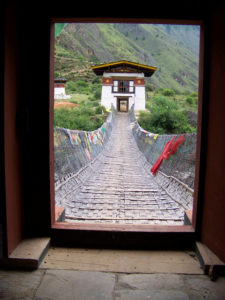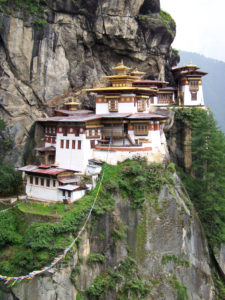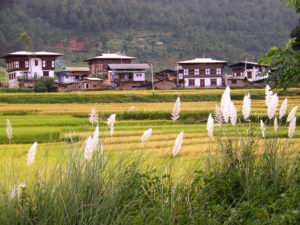Bhutan’s environmental policies serve as an example of forward thinking for the rest of the world. A key foundation for Bhutan’s policies is included in the Constitution, and requires that 60 percent of the country will remain in forest cover for all time to come. His Majesty King Jigme Singye Wangchuck’s goal of happiness sustained by Bhutan’s distinct cultural identity and a pristine ecology has led to an environmental strategy of “treading the Middle Path to sustainable development.â€Â  This strategy is being tested to increasing degrees as the pressures of population growth, development, and increased use of natural resources press on the natural areas of Bhutan.

We are honored and fortunate as visitors from the United States to have met with government officials and local residents to learn about the environmental vision of Bhutan. We also have experience from the environmental pitfalls and problems in the United States and other countries when the cumulative impacts of growth and development were not fully balanced with ecological understanding. Along these lines there are important areas of focus as growth proceeds. These include (1) ecologically sound land use planning, (2) application of conservation development principles, (3) the use of alternative storm water management practices to protect surface and groundwater, and (4) climate change/global warming. Each of these four areas seeks ecological balance and is discussed here in light of His Majesty King Jigme Singye Wangchuck’s goal stated above.
 Deputy Minister of Environment Dasho Nado Rinchhen honored us with a meeting in which we discussed Bhutan’s vision, goals and future challenges. The Deputy Minister said, “His Majesty has learned from other countries that spiritual growth is needed in addition to normal government policies. People need clean water and fresh air.â€Â The Deputy Minister reviewed three areas of socio-economic programs. These include: (1) Improvements in agriculture and intensification of productivity, (2) Development of hydro-electric power using run of the river projects, and (3) modest industrialization. These programs have direct growth implications regarding the four focus areas we mentioned above. With a projected 3 percent per year population increase, Bhutan could see a doubling of its population in the next twenty years. This means more houses, more use of natural resources, greater impacts to water and air quality, and the stressing of protected areas and other forested lands.
Deputy Minister of Environment Dasho Nado Rinchhen honored us with a meeting in which we discussed Bhutan’s vision, goals and future challenges. The Deputy Minister said, “His Majesty has learned from other countries that spiritual growth is needed in addition to normal government policies. People need clean water and fresh air.â€Â The Deputy Minister reviewed three areas of socio-economic programs. These include: (1) Improvements in agriculture and intensification of productivity, (2) Development of hydro-electric power using run of the river projects, and (3) modest industrialization. These programs have direct growth implications regarding the four focus areas we mentioned above. With a projected 3 percent per year population increase, Bhutan could see a doubling of its population in the next twenty years. This means more houses, more use of natural resources, greater impacts to water and air quality, and the stressing of protected areas and other forested lands.
To prepare for growth and managing environmental impacts Bhutan has put into place the Environmental Assessment Act 2000, the Forest and Nature Conservation Act 1995, the Mines and Minerals Act 1995, and Land Act 1997. These are some of the most forward thinking environmental protection policies of any government. Furthermore, the National Environment Protection Act passed in the June/July 2007 parliamentary section is an umbrella act, and it is within this act that 60 percent forest cover for Bhutan is required. Chief Forest Officer Raling Hgawang Drukdra discussed forest management practices that are being designed to achieve sustainability.  These aggressive acts and practices are model legislation for many of the developed nations, such as the United States, that have poorly managed their natural resources. In our work as ecologists we will bring these examples back to the United States and other countries and integrate Bhutan’s policies into the progressive programs we have been managing.
 The four focus areas we mentioned above can also be included to a greater extent in Bhutan’s legislation. For example the first focus of ecologically sound land use planning would seek to integrate the cumulative impacts of multiple projects as environmental Impact Assessments are produced for individual projects. The cumulative impacts on water and air quality and human health within a community are often missed when projects are assessed only on an individual basis. Just as the National Environment Protection Act is an umbrella over the other acts, so can the development of a cumulative impacts policy. This would require the integration of data from all area projects, the regional assessment of ecosystem impact rather than just local assessment, and the development of protective measures and remediation planning to improve the environment.
The four focus areas we mentioned above can also be included to a greater extent in Bhutan’s legislation. For example the first focus of ecologically sound land use planning would seek to integrate the cumulative impacts of multiple projects as environmental Impact Assessments are produced for individual projects. The cumulative impacts on water and air quality and human health within a community are often missed when projects are assessed only on an individual basis. Just as the National Environment Protection Act is an umbrella over the other acts, so can the development of a cumulative impacts policy. This would require the integration of data from all area projects, the regional assessment of ecosystem impact rather than just local assessment, and the development of protective measures and remediation planning to improve the environment.
Our second area of focus is the application of conservation development principles, and addresses housing and multiple land use development. Conservation developments typically seek to retain greater than 50 percent natural areas within a given development project area. They also include the use of ecologically balanced landscape architecture, planning and management – such as requiring cluster housing, smaller yards, smaller houses, renewable energy, and education in regards to the importance of the environment. Features such as the use of wetlands, green drainage swales, groundwater infiltration spaces, and rain gardens all utilize native plant species, while reducing the use of curb and gutter on roads and local alternative storm water management (see below). An ecological management fund based on money collected on the sale of each home (for example 0.5% of the sale price) in the development can be used to manage ecological features that protect water quality and quantity and habitats.
Alternative storm water management practices use natural solutions to protect surface and groundwater rather than classical engineering approaches. The alternative practices include narrower roads (less impervious area), streets without cub and gutters, the use of constructed wetland and forest areas for groundwater infiltration zones, pervious pavements, green roofs, and rain gardens. The goal of alternative storm water management is to manage rainwater where it falls, rather than accumulate it through a storm water sewer system. Infiltration is a key to the success of this approach. The classical designs of using curb and gutters, storm sewers, and storm water detention basins impede groundwater recharge and infiltration. Roof water can also be utilized in native species or organic vegetable gardens called “rain gardens†in individual yards, thereby by-passing the need for additional drains and storm sewer connections.
 Finally, climate change and global warming are of increasing concern. Deputy Minister Dasho Nado Rinchhen is very aware that climate change and global warming are affecting Bhutan and the world. He said, “I have seen in thirty years warmer winters and less snow in Bhutan. Some species, such as banana trees, could not survive in Thimphu in decades past, but now they survive the winter.â€Â The Deputy Minister said that he would hope the United States leads the world in fighting global warming. He viewed the global warming documentary “An Inconvenient Truth†produced by Al Gore, former U.S. Vice President, and said it was so important he showed it to members of his staff. The Deputy Minister noted that Bhutan is a “Carbon Bank†for the world because of its high percentage of forest preservation, and that the world should recognize this fact. We will endeavor to carry the Deputy Minister’s observations back to Members of Congress in the United States.
Finally, climate change and global warming are of increasing concern. Deputy Minister Dasho Nado Rinchhen is very aware that climate change and global warming are affecting Bhutan and the world. He said, “I have seen in thirty years warmer winters and less snow in Bhutan. Some species, such as banana trees, could not survive in Thimphu in decades past, but now they survive the winter.â€Â The Deputy Minister said that he would hope the United States leads the world in fighting global warming. He viewed the global warming documentary “An Inconvenient Truth†produced by Al Gore, former U.S. Vice President, and said it was so important he showed it to members of his staff. The Deputy Minister noted that Bhutan is a “Carbon Bank†for the world because of its high percentage of forest preservation, and that the world should recognize this fact. We will endeavor to carry the Deputy Minister’s observations back to Members of Congress in the United States.
We are very impressed by the environmental policies of Bhutan, and wish to commend His Majesty and the law makers on their efforts to protect the natural resources of their country. We will carry the lessons learned here to other projects and regions, and hold Bhutan as an example to be followed by other governments. We also hope that the lessons learned in other countries can be used here to avoid many of the pitfalls associated with growth and development that are now impacting Bhutan.
